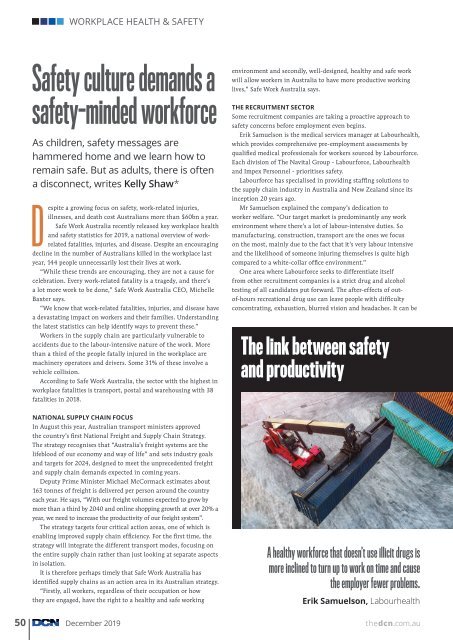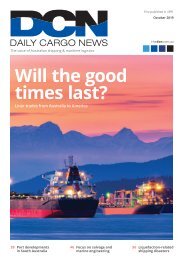DCN December Edition 2019
Create successful ePaper yourself
Turn your PDF publications into a flip-book with our unique Google optimized e-Paper software.
WORKPLACE HEALTH & SAFETY<br />
Safety culture demands a<br />
safety-minded workforce<br />
As children, safety messages are<br />
hammered home and we learn how to<br />
remain safe. But as adults, there is often<br />
a disconnect, writes Kelly Shaw*<br />
Despite a growing focus on safety, work-related injuries,<br />
illnesses, and death cost Australians more than $60bn a year.<br />
Safe Work Australia recently released key workplace health<br />
and safety statistics for <strong>2019</strong>, a national overview of workrelated<br />
fatalities, injuries, and disease. Despite an encouraging<br />
decline in the number of Australians killed in the workplace last<br />
year, 144 people unnecessarily lost their lives at work.<br />
“While these trends are encouraging, they are not a cause for<br />
celebration. Every work-related fatality is a tragedy, and there’s<br />
a lot more work to be done,” Safe Work Australia CEO, Michelle<br />
Baxter says.<br />
“We know that work-related fatalities, injuries, and disease have<br />
a devastating impact on workers and their families. Understanding<br />
the latest statistics can help identify ways to prevent these.”<br />
Workers in the supply chain are particularly vulnerable to<br />
accidents due to the labour-intensive nature of the work. More<br />
than a third of the people fatally injured in the workplace are<br />
machinery operators and drivers. Some 31% of these involve a<br />
vehicle collision.<br />
According to Safe Work Australia, the sector with the highest in<br />
workplace fatalities is transport, postal and warehousing with 38<br />
fatalities in 2018.<br />
environment and secondly, well-designed, healthy and safe work<br />
will allow workers in Australia to have more productive working<br />
lives,” Safe Work Australia says.<br />
THE RECRUITMENT SECTOR<br />
Some recruitment companies are taking a proactive approach to<br />
safety concerns before employment even begins.<br />
Erik Samuelson is the medical services manager at Labourhealth,<br />
which provides comprehensive pre-employment assessments by<br />
qualified medical professionals for workers sourced by Labourforce.<br />
Each division of The Navital Group - Labourforce, Labourhealth<br />
and Impex Personnel - prioritises safety.<br />
Labourforce has specialised in providing staffing solutions to<br />
the supply chain industry in Australia and New Zealand since its<br />
inception 20 years ago.<br />
Mr Samuelson explained the company’s dedication to<br />
worker welfare. “Our target market is predominantly any work<br />
environment where there’s a lot of labour-intensive duties. So<br />
manufacturing, construction, transport are the ones we focus<br />
on the most, mainly due to the fact that it’s very labour intensive<br />
and the likelihood of someone injuring themselves is quite high<br />
compared to a white-collar office environment.”<br />
One area where Labourforce seeks to differentiate itself<br />
from other recruitment companies is a strict drug and alcohol<br />
testing of all candidates put forward. The after-effects of outof-hours<br />
recreational drug use can leave people with difficulty<br />
concentrating, exhaustion, blurred vision and headaches. It can be<br />
The link between safety<br />
and productivity<br />
NATIONAL SUPPLY CHAIN FOCUS<br />
In August this year, Australian transport ministers approved<br />
the country’s first National Freight and Supply Chain Strategy.<br />
The strategy recognises that “Australia’s freight systems are the<br />
lifeblood of our economy and way of life” and sets industry goals<br />
and targets for 2024, designed to meet the unprecedented freight<br />
and supply chain demands expected in coming years.<br />
Deputy Prime Minister Michael McCormack estimates about<br />
163 tonnes of freight is delivered per person around the country<br />
each year. He says, “With our freight volumes expected to grow by<br />
more than a third by 2040 and online shopping growth at over 20% a<br />
year, we need to increase the productivity of our freight system”.<br />
The strategy targets four critical action areas, one of which is<br />
enabling improved supply chain efficiency. For the first time, the<br />
strategy will integrate the different transport modes, focusing on<br />
the entire supply chain rather than just looking at separate aspects<br />
in isolation.<br />
It is therefore perhaps timely that Safe Work Australia has<br />
identified supply chains as an action area in its Australian strategy.<br />
“Firstly, all workers, regardless of their occupation or how<br />
they are engaged, have the right to a healthy and safe working<br />
A healthy workforce that doesn’t use illicit drugs is<br />
more inclined to turn up to work on time and cause<br />
the employer fewer problems.<br />
Erik Samuelson, Labourhealth<br />
50 <strong>December</strong> <strong>2019</strong><br />
thedcn.com.au
















